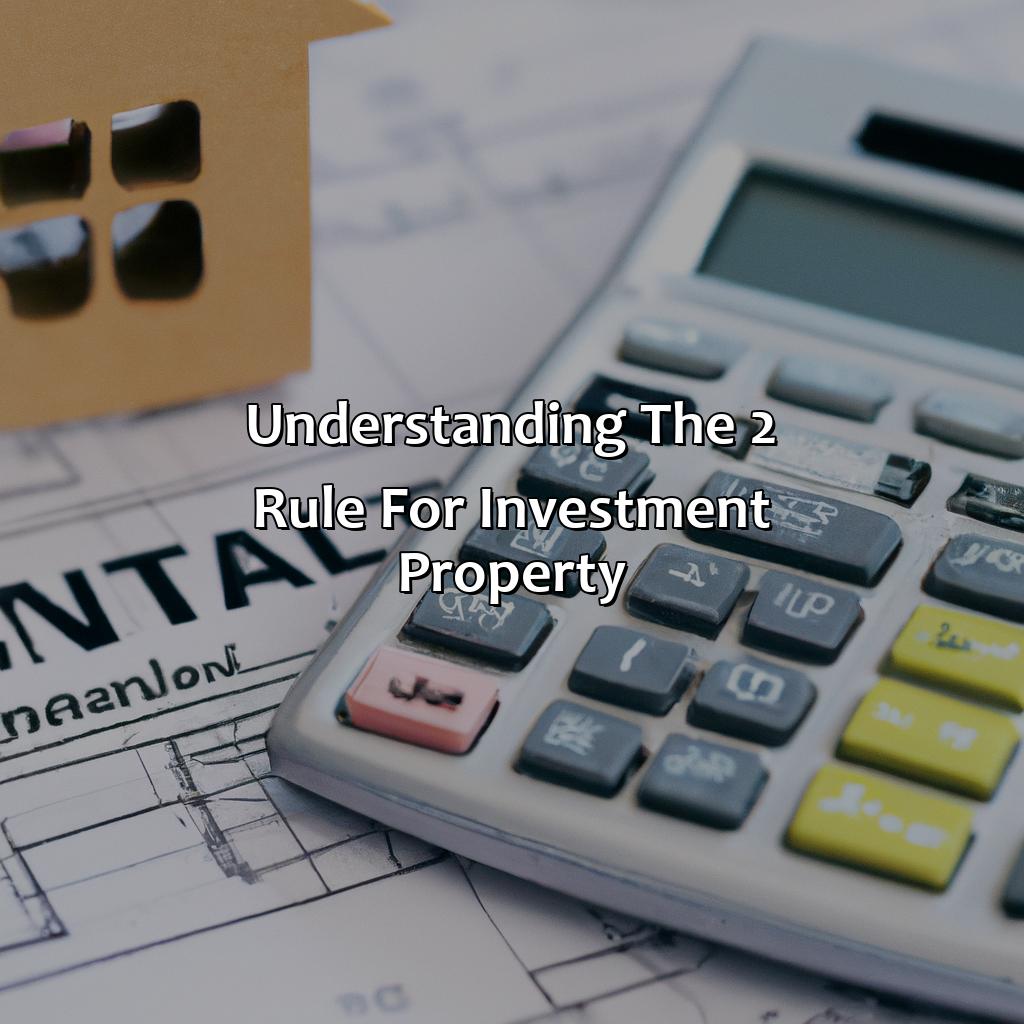What Is The 2% Rule For Investment Property?
Example Response:
Key Takeaway:
- The 2% rule is a guideline used by real estate investors to determine if a rental property is worth investing in. The rule states that the monthly rental income should be at least 2% of the purchase price of the property.
- The 2% rule is a quick and easy way to evaluate potential investment properties and can help investors avoid properties that are not likely to generate a good return on investment.
- Factors to consider when using the 2% rule include property location, condition, and potential for appreciation. It is also important to consider other expenses such as taxes, insurance, and maintenance costs when evaluating a property.
Are you looking to invest in property? If so, you should know about the 2% rule. It’s a useful guideline that helps you decide if an investment property is worth pursuing. With this article, you’ll understand the ins and outs of the 2% rule and how it can benefit your investment portfolio.
Understanding the 2% Rule for Investment Property
Investment property owners use the 2% rule to assess their property’s potential profitability. It means that the monthly rent should be at least 2% of its total purchase price. The rule helps to estimate the cash flow a property can generate. By using this rule, investors can determine if a particular property is a wise investment or not. However, this rule alone cannot guarantee success. It is crucial to consider other factors such as other expenses, maintenance costs, occupancy rates, and more which can impact its overall profitability.
In addition to the 2% rule, investors should also consider factors such as location, housing demand, and rental rates in the area. Areas with high demand and rental rates are ideal for profitable investments. Investors should also aim to manage their expenses by cutting down costs on regular maintenance and property management. By regularly examining and updating their investment strategies, owners can maximize their property’s cash flow potential over time.
Investors can also consider alternative strategies. They can look for undervalued properties or opt for creative financing options. They can also invest in multi-unit properties or properties that offer multiple revenue streams such as commercial spaces or shared workspaces. Each strategy has its advantages and disadvantages. Therefore, it’s essential to analyze which approach best aligns with the owner’s goals, investment horizon, and risk tolerance.

Image credits: retiregenz.com by Yuval Arnold
What is the 2% Rule?
Understand the 2% Rule for investment property? Need to know its definition and how it functions. Here’s a full breakdown. Definition first. Then, check out an example of how the rule works. Get that deep understanding!

Image credits: retiregenz.com by Adam Arnold
Definition of the 2% Rule
The 2% rule is a popular benchmark used in the field of real estate investing. It refers to the ratio between the monthly rent received from an investment property and its purchase price. According to this rule, a property’s monthly rent should be at least 2% of its total purchase price. This provides investors with a guideline for quickly filtering potential investment properties based on their potential return on investment.
Investors use the 2% rule to evaluate whether a property is worth investing in or not. It helps them estimate their potential cash flow and profitability quickly. If the monthly rent amount is less than 2% of the purchase price, then it might not be profitable, and they should consider other options.
When considering the 2% rule, investors need to take into account all costs associated with owning and managing an investment property, including taxes, insurance premiums, repairs, maintenance fees, and vacancy rates.
According to Forbes magazine, rental yields in some U.S cities are higher than others. For example, in Orlando and Tampa Bay Florida can be as high as over 10%, whereas places like Los Angeles has a rental yield closer to almost approximately 4%.
Breaking it down for the mathematically-challenged: the 2% rule means your monthly rent should be at least 2% of the property’s purchase price.
Explaining How the 2% Rule Works
The 2% Rule is a popular investment strategy that many real estate investors swear by. The rule advocates that the monthly rent of a property should be at least 2% of its total purchase price. This means that if you purchase a $200,000 property, it should be rented out for at least $4,000 per month.
The idea behind the 2% Rule is to ensure that the investment generates enough cash flow and returns to help pay off mortgages, cover maintenance costs, and yield profits on top. However, keep in mind that this rule alone does not guarantee profitability or success. It’s still essential to factor in other expenses and variables such as taxes or vacancies.
It’s crucial to understand that the 2% Rule may not apply to every market or scenario. Some areas with low property values may require more flexibility, while high demand markets may allow for stricter standards. As always, conduct thorough research and analysis before making any investments.
A seasoned real estate investor once shared his experience with the 2% Rule. He was skeptical at first but decided to give it a try by purchasing a modestly priced property in an up-and-coming neighborhood. Within two years, he had made enough profit from rental income and appreciation to reinvest in additional properties using the same formula.
Applying the 2% Rule to investment property is like finding a needle in a haystack, if the needle was made of gold and the haystack was on fire.
Applying the 2% Rule in Investment Property
The 2% rule is an excellent way to invest in property, but it’s important to understand the advantages and factors involved. We’ll break down the components so you can make wise investment choices. Examples of implementation are also included to help you further.

Image credits: retiregenz.com by James Arnold
Advantages of Using the 2% Rule
The benefits of incorporating the 2% Rule in Investment Property are significant. Here are six advantages:
- Allows for better screening of potential income properties
- Optimizes decision-making when evaluating rental properties
- Provides clear and concise metrics for gauging property profitability
- Achieves a higher return on investment (ROI)
- Limits risk by ensuring a solid cash flow from the property
- Hedges against unforeseen financial risks or expenses
It is essential to understand that using the 2% Rule does not guarantee a successful real estate investment, but it can assist investors in analyzing a property’s profitability before making an investment.
One crucial aspect to consider when applying the 2% Rule is that different markets and locations will have varying levels of return on investments. Thus, doing proper due diligence on specific areas is critical for success.
The story goes like this: A real estate investor was torn between two potential properties to purchase. Both met the 2% Rule criteria on paper, but he decided to choose one over the other based on his gut feeling. The property he selected turned out to be more profitable than expected, proving the importance of using both analytics and intuition when investing in real estate.
Don’t forget to factor in the cost of therapy when using the 2% rule, because watching your bank account dwindle can be traumatic.
Factors to Consider When Using the 2% Rule
When Applying the 2% Rule in Investment Property, there are several essential considerations to keep in mind before making any investment decisions. These considerations include property tax rates, vacancy rates, purchase price, maintenance costs, and location.
- Property Tax Rates: Property taxes can differ significantly from one jurisdiction to another. Therefore, it is essential to research the property tax rate in the location that you plan to invest in.
- Vacancy Rates: Ensure that the area where you plan to invest has a low vacancy rate as high vacant rates can lead to shorter rental periods and reduced income.
- Purchase Price: The initial cost of investment should be significantly lower than your expected returns so that it remains profitable.
- Maintenance Costs: Ensure that you have an idea of how much the necessary repairs will cost so that you do not end up cash flow negative as maintenance bills add up over time.
- Location: Location is another critical consideration because different areas have distinct markets with varying rental values or trends. Choose a location that suits your tenant’s needs for easy occupancy and also easily accessible by tenants.
A thorough understanding of these points is crucial when making investment decisions based on the 2% rule to avoid losses and make profits.
It is essential always to remember that the 2% rule is just one of many rules available for calculating perfect properties suitable for an investor’s portfolio.
According to Forbes reports, implementing the 2% rule in investment property systematically helps investors pre-select properties more objectively and automate their preliminary screening process conveniently.
Examples of Implementing the 2% Rule in Property Investment
Applying the 2% Rule in Property Investment can be a challenging decision, but it is essential for a successful investment plan. Here are some examples of how you can implement this rule in your property investment:
- Find properties that meet the 2% Rule criteria i.e.the rental income should be at least 2% of the property’s value
- Verify the market potential and future growth prospects
- Check the area to ensure demand and interest from tenants is high
- Confirm vacancy rates which could negatively impact expected rental income
- Note mortgage and tax obligations before making an investment decision.
When applying this rule, always ensure that your monthly income generated from rent meets or exceeds your total cost of ownership by at least 2%. This ensures that your investment remains profitable in the long term.
It’s crucial to keep adapting to changes affecting rental demand or supply to make informed decisions. Based on recent challenges with COVID-19 lockdowns, a landlord had decided not to evict her tenant who suffered job loss during lockdown, granting them time to get back on their feet again as soon as possible.
Investing in property has its perks, however being meticulous with research and projecting future risks should remain a prime concern. Applying the 2% rule can help streamline one’s due diligence when it comes to securing a profitable return on one’s investment— month-after-month-year after year.
Some Facts About the 2% Rule for Investment Property:
- ✅ The 2% rule is a guideline for real estate investors to determine if a rental property will generate enough income to cover expenses and provide a return on investment. (Source: Mashvisor)
- ✅ According to the 2% rule, the monthly rental income should be at least 2% of the property purchase price. (Source: BiggerPockets)
- ✅ The 2% rule can be used as a quick initial screening tool, but should not be the only factor considered when evaluating a potential rental property. (Source: Roofstock)
- ✅ The 2% rule may not apply in all markets, particularly in more expensive areas where rental properties are harder to come by. (Source: Forbes)
- ✅ Experienced investors often use a modified version of the 2% rule, which takes into account factors such as property location, condition, and potential for appreciation. (Source: Real Wealth Network)
FAQs about What Is The 2% Rule For Investment Property?
What is the 2% rule for investment property?
The 2% rule for investment property is a guideline that states the monthly rent should be equal to or greater than 2% of the purchase price of the property.
Why is the 2% rule important?
The 2% rule is important because it helps investors to quickly evaluate the potential profitability of an investment property. It also helps to ensure that the property generates enough cash flow to cover expenses and leave room for a profit.
Is the 2% rule always accurate?
No, the 2% rule is not always accurate and should be used as a guideline, not a strict rule. The actual profitability of an investment property depends on many factors such as location, property condition, and market trends.
What are the risks of relying solely on the 2% rule?
Relying solely on the 2% rule can lead to overlooking important factors such as the condition of the property, market trends, and the potential for future appreciation. It can also lead to investing in properties that may be difficult to rent or require costly repairs.
Can the 2% rule be applied to commercial properties?
While the 2% rule is primarily used for residential properties, it can be applied to some commercial properties such as multifamily buildings. However, it may not be as accurate for commercial properties due to differences in expenses and rental rates.
How can investors ensure profitability beyond the 2% rule?
Investors can ensure profitability beyond the 2% rule by conducting thorough market research, analyzing potential expenses, and accurately assessing the property’s condition. It is also important to have a solid investment plan and to keep a reserve fund for unexpected expenses.
